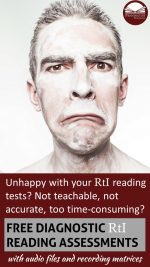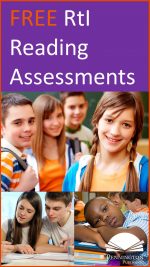RtI Reading Tests and Resources
Teachers like to teach, not test. After years of required testing, many teachers develop a healthy dose of test aversion. This condition exists because teachers perceive that testing takes away time from teaching, which is their first priority and first love. I’ve yet to meet a teacher when asked, “Why did you get into teaching?” who answered, “Because I love testing.”
Test aversion is accentuated by assessments which provide no teachable data. Of course, the PARCC and SBAC tests come to mind; however, many other assessments, such as random sample normed assessments, contribute to this progressive disease. This is particularly the case within programs designed to meet individual student needs, such as reading intervention. Response to Intervention (RtI) reading assessments are widely perceived as top-down requirements which are time-consuming exercises in test administration, grading, recording, and monitoring: all of which take away teaching time, add countless hours of paperwork, and subject teachers to unfair administrative or peer scrutiny. Think awkward group meetings.
In fact, RtI reading tests can be counterproductive. Years ago I served as a site-level reading specialist at an elementary school. The principal had reached out to district program specialists to develop an RtI-style assessment package for administration to second and third-graders, as well as to fourth, fifth, and sixth-grade students who scored poorly on the standardized tests. Part of the assessment package was the SORT (Slosson Oral Reading Test). The SORT is an individually administered assessment, which takes from 2-4 minutes to administer and score. Merits of this test aside (I’ve always found the test useful as a predictor of reading comprehension grade level), the principal and teachers decided to teach-to-the-test. Teachers, instructional aids, and parents spent countless hours quizzing students with Slosson word flashcards memorizing this random sample test. Time is reductive. Teaching to this test was counterproductive.
So, does assessment have its place? Will teachers buy-in to the value of RtI reading tests? Absolutely. The cure to test aversion? Assessment-based instruction. Following are the criteria for assessment-based instruction:
Seven Assessment-based Criteria
- Comprehensive: Each assessment is comprehensive, not a normed random sample. For example, teachers don’t want a 20-question qualitative spelling inventory indicating that students haven’t mastered some or all of their short and long vowels. Teachers want to know exactly which short and long vowels have and have not been mastered. Hence the 102 item Diagnostic Spelling Assessment.
- Accurate (internally valid) and Reliable (externally valid)
- Quick and Easy Administration: All but one assessment (fluency) are whole class assessments.
- Easy to Grade and Record: have audio files for easy test administration.
- Easy-to-Monitor
- Teachable: teach to the results of each test item.
- Designed for Response to Intervention
Response to Intervention Reading Tests
So which RtI reading tests meet those criteria? The comprehensive alphabetic, phonological (phonemic awareness), phonics, sight words, sight syllables, reading fluency, and spelling assessments for site-level Response to Intervention teams and individual teachers help teachers quickly and accurately diagnose what students know and what they do not know. Each assessment has been developed by Mark Pennington, M.A. Reading Specialist, and revised from extensive teacher feedback. The assessments are offered absolutely FREE for classroom use. Why FREE?
As the author of these assessments, I care about creating assessments that teachers value as reliable diagnostic tools for their students. I also know that once teachers determine what students know and don’t know, they will want the corresponding resources to teach to the diagnosed reading deficits. Of course, teachers can use their own resources, but I hope that they’ll purchase mine. Each program resource corresponds to the FREE reading assessments, test item by test item.
The author’s assessment-based phonemic awareness, phonics, reading fluency and comprehension, syllabication, vocabulary, and spelling programs provide the resources for assessment-based whole class and individualized instruction. Click on the links to FREE reading assessments and the corresponding curricular resources.
Phonemic Awareness and Alphabetic Awareness (Paper Copies)
Use these five phonemic awareness (syllable awareness, syllable rhyming, phonemic isolation, phonemic blending, phonemic segmenting) and two alphabetic awareness assessments (upper and lower case identification and application) to determine reading readiness. Each of the seven assessments is administered whole class.
- Syllable Awareness Assessment (5:48 Audio File)
- Syllable Rhyming Assessment (5:38 Audio File)
- Phonemic Isolation Assessment (5:54 Audio File)
- Phonemic Blending Assessment (5:53 Audio File)
- Phonemic Segmenting Assessment (5:21 Audio File)
Vowel Sounds Phonics Assessment (Paper Copy) *
Use this comprehensive 52 item whole class assessment to determine your students’ mastery of short vowels, long vowels, silent final e, vowel digraphs, vowel diphthongs, and r-controlled vowels. The assessment uses nonsense words to test students’ knowledge of the sound-spellings to isolate the variable of sight word recognition. Unlike other phonics assessments, this assessment is not a random sample of phonics knowledge. The Vowel Sounds Phonics Assessment includes every common sound-spelling. Thus, the results of the assessment permit targeted instruction in any vowel sound phonics deficits.
- Vowel Sounds Phonics Assessment (10:42 Audio File)
Consonant Sounds Phonics Assessment (Paper Copy) *
Use this comprehensive 50 item whole class assessment to determine your students’ mastery of consonant digraphs, beginning consonant blends, and ending consonant blends. The assessment uses nonsense words to test students’ knowledge of the sound-spellings to isolate the variable of sight word recognition. Unlike other phonics assessments, this assessment is not a random sample of phonics knowledge. The Consonant Sounds Phonics Assessment includes every common sound-spelling. Thus, the results of the assessment permit targeted instruction in any consonant sound phonics deficits.
- Consonant Sounds Phonics Assessment (12:07 Audio File)
Sight Words (Outlaw Words) Assessment (Paper Copy)
Use this 99 item whole class assessment to determine your students’ mastery of the most common non-phonetic English words. The author’s Teaching Reading Strategies reading intervention program includes small group activities to remediate all deficits indicated by this 15-minute assessment. The program includes an Outlaw Words fluency article which uses all assessment sight words. The program also provides sight word game card masters and individual sets of business card size Reading and Spelling Game Cards.
Sight Syllables Assessment (Paper Copy)
Use this 49 item whole class assessment to determine your students’ mastery of the most common Greek and Latin prefixes and suffixes. Memorization and practice of these high utility affixes will assist with syllabication, spelling, and vocabulary development.
The Pets Fluency Assessment (Paper Copy) *
The “Pets” expository fluency passage is leveled in a unique pyramid design: the first paragraph is at the first grade (Fleish-Kincaid) reading level; the second paragraph is at the second grade level; the third paragraph is at the third grade level; the fourth paragraph is at the fourth grade level; the fifth paragraph is at the fifth grade level; the sixth paragraph is at the sixth grade level; and the seventh paragraph is at the seventh grade level. Thus, the reader begins practice at an easier level to build confidence and then moves to more difficult academic language. As the student reads the fluency passage, the teacher will be able to note the reading levels at which the student has a high degree of accuracy and automaticity. Automaticity refers to the ability of the reader to read effortlessly without stumbling or sounding-out words. The 383 word passage permits the teacher to assess two-minute reading fluencies (a much better measurement than a one-minute timing).
The author’s reading intervention program includes 43 expository animal fluency articles, each marked with words per line and timing charts to help students monitor their own fluency progress. Plus, each of the 43 fluency articles has been recorded at three different reading speeds to provide the appropriate challenge level for each of your students. This toolkit provides the YouTube links to these 129 modeled readings.
Each of the 43 articles is composed in a leveled format: the first two paragraphs are at third grade reading level, the next two are at the fifth grade reading level, and the last two are at the seventh grade reading level. Slower readers get practice on controlled vocabulary and are pushed to read at the higher reading levels, once the contextual content has been established. Faster readers are challenged by the increasingly difficult multi-syllabic vocabulary.
The program also provides 43 corresponding animal comprehension worksheets with content-specific comprehension questions listed in the margins next to the relevant text. These low-higher order thinking questions ask readers to summarize, connect, re-think, interpret, and predict (the SCRIP comprehension strategy) to promote reader dialog with the text. Students practice self-monitoring their own reading comprehension as they read. This “talking to the text” transfers to better independent reading comprehension and retention.
Diagnostic Spelling Assessment (Paper Copy) *
Use this comprehensive diagnostic assessment to pinpoint all sound-spelling patterns learned from kindergarten through eighth grade. This 102 item eighth grade test pinpoints spelling deficits and allow the teacher to individualize instruction according to the assessment-data. The author’s Grades 4-8 Differentiated Spelling Instruction programs (American English and Canadian English) provide grade-level lists, sorts, and remedial worksheets (each with a formative assessment) to teach every spelling pattern found in the diagnostic. Truly assessment-based instruction!
- Diagnostic Spelling Assessment (22:38 Audio File)
* Placement Assessments
Spelling Patterns Assessment Matrix
Reading Assessments Recording Matrix
*****

The Science of Reading Intervention Program
The Science of Reading Intervention Program: Word Recognition includes explicit, scripted, sounds to print instruction and practice with the 5 Daily Google Slide Activities every grades 4-adult reading intervention student needs: 1. Phonemic Awareness and Morphology 2. Blending, Segmenting, and Spelling 3. Sounds and Spellings (including handwriting) 4. Heart Words Practice 5. Sam and Friends Phonics Books (decodables). Plus, digital and printable sound wall cards, speech articulation songs, sounds to print games, and morphology walls. Print versions are available for all activities. First Half of the Year Program (55 minutes-per-day, 18 weeks)
The Science of Reading Intervention Program: Language Comprehension resources are designed for students who have completed the word recognition program or have demonstrated basic mastery of the alphabetic code and can read with some degree of fluency. The program features the 5 Weekly Language Comprehension Activities: 1. Background Knowledge Mentor Texts 2. Academic Language, Greek and Latin Morphology, Figures of Speech, Connotations, Multiple Meaning Words 3. Syntax in Reading 4. Reading Comprehension Strategies 5. Literacy Knowledge (Narrative and Expository). Second Half of the Year Program (30 minutes-per-day, 18 weeks)
The Science of Reading Intervention Program: Assessment-based Instruction provides diagnostically-based “second chance” instructional resources. The program includes 13 comprehensive assessments and matching instructional resources to fill in the yet-to-be-mastered gaps in phonemic awareness, alphabetic awareness, phonics, fluency (with YouTube modeled readings), Heart Words and Phonics Games, spelling patterns, grammar, usage, and mechanics, syllabication and morphology, executive function shills. Second Half of the Year Program (25 minutes-per-day, 18 weeks)
The Science of Reading Intervention Program BUNDLE includes all 3 program components for the comprehensive, state-of-the-art (and science) grades 4-adult full-year program. Scripted, easy-to-teach, no prep, no need for time-consuming (albeit valuable) LETRS training or O-G certification… Learn as you teach and get results NOW for your students. Print to speech with plenty of speech to print instructional components.
Click the SCIENCE OF READING INTERVENTION PROGRAM RESOURCES for detailed program description, sample lessons, and video overviews. Click the links to get these ready-to-use resources, developed by a teacher (Mark Pennington, MA reading specialist) for teachers and their students.
Get the SCRIP Comprehension Cues FREE Resource:
![]()
Get the Diagnostic ELA and Reading Assessments FREE Resource:![]()
*****

